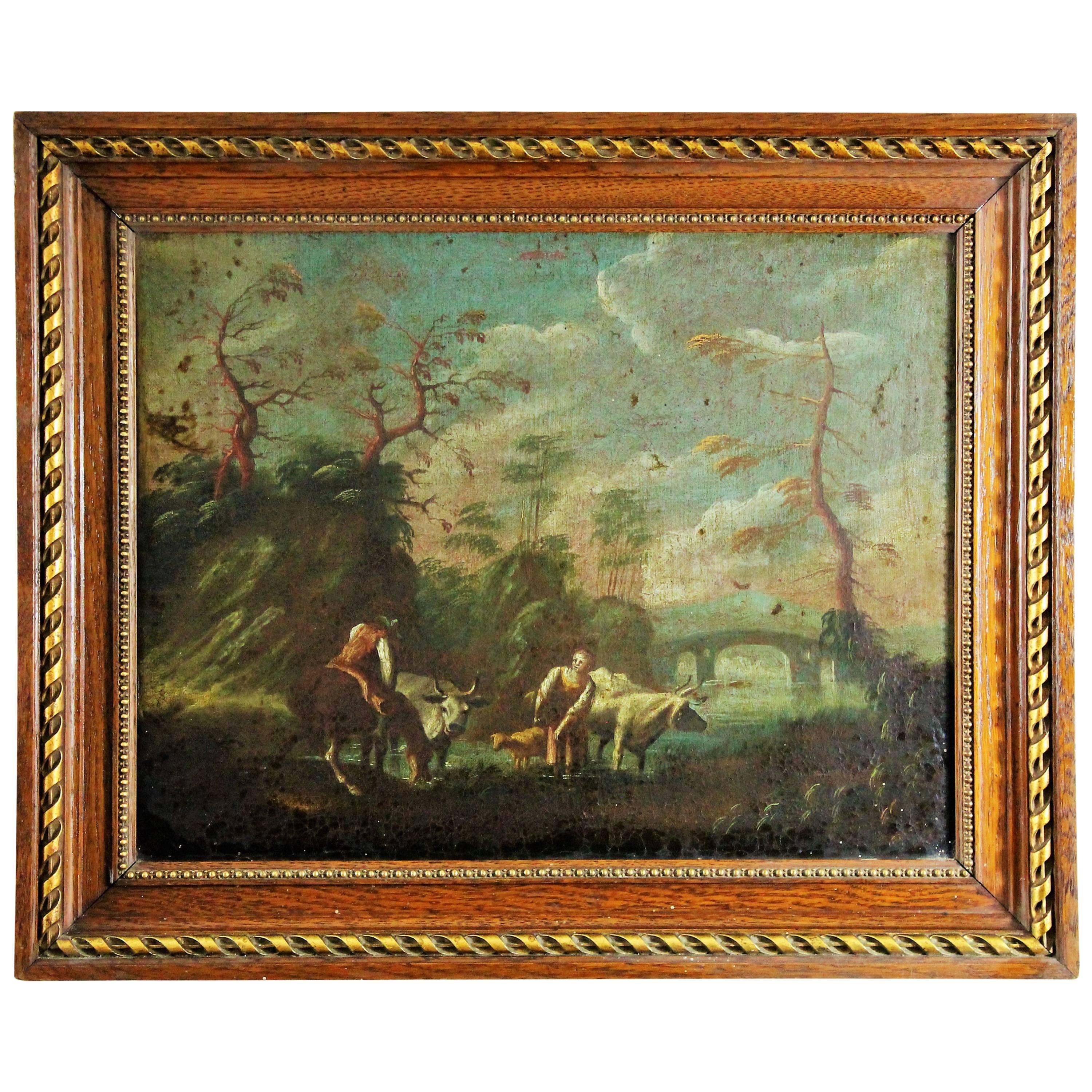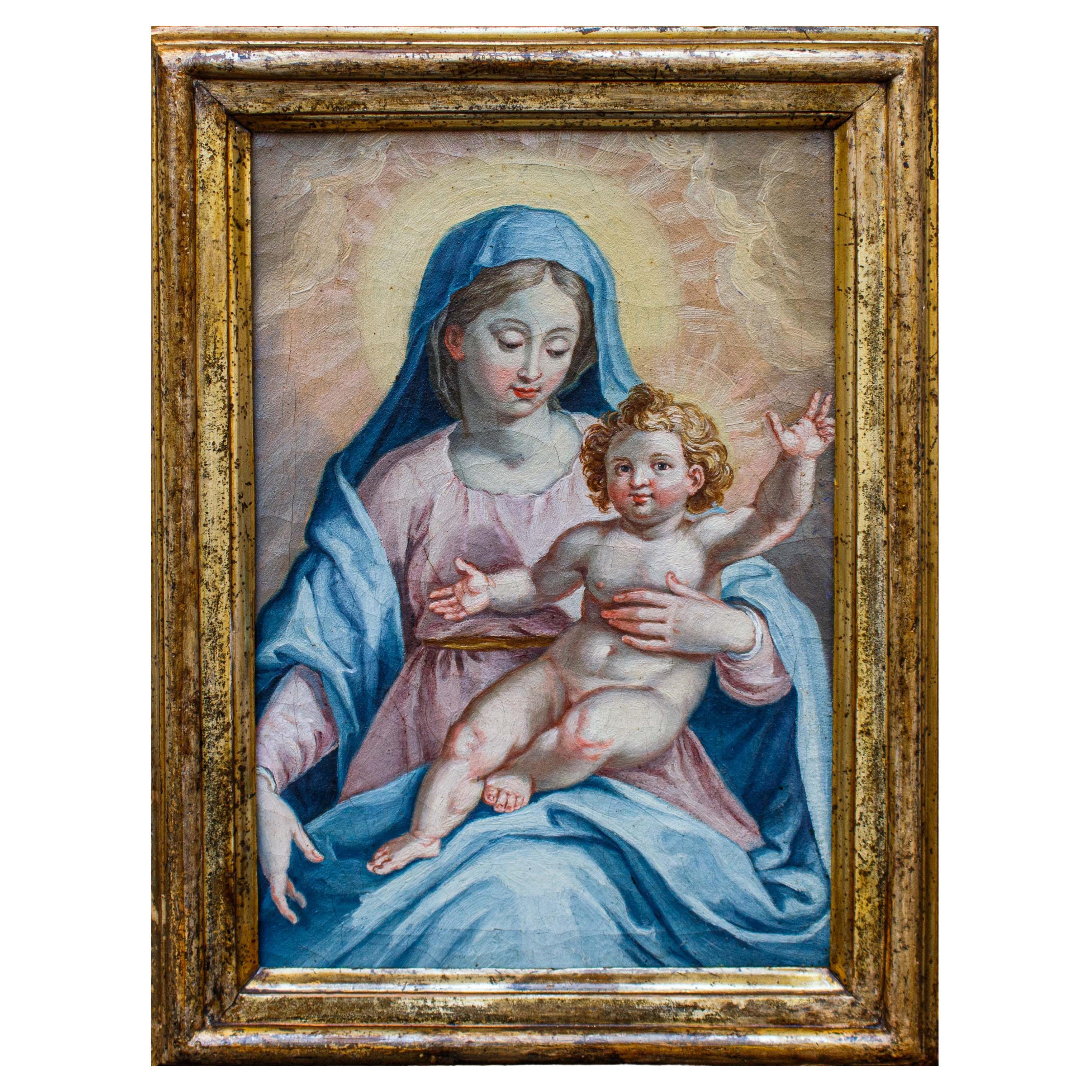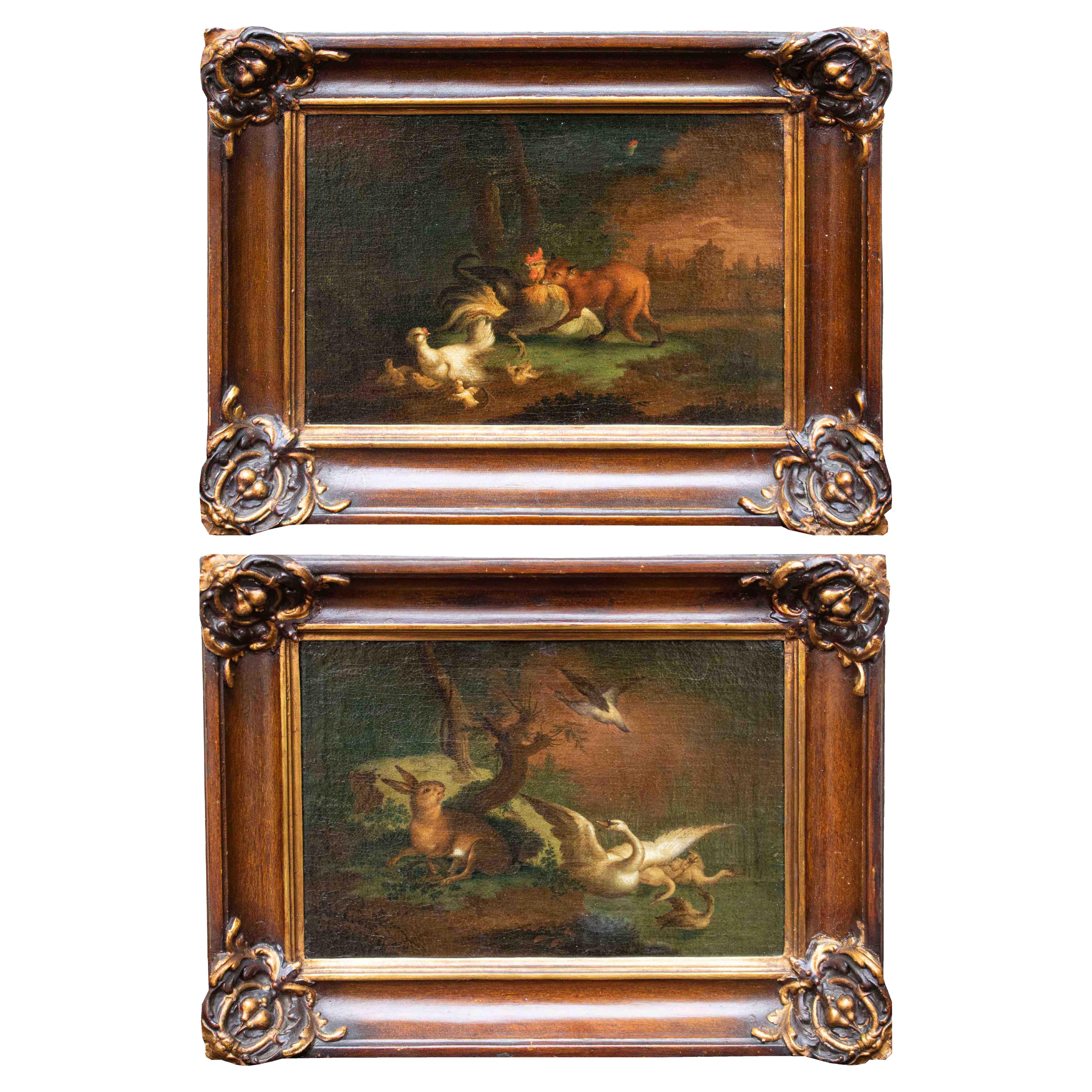Items Similar to 17th Century Angelica and Medoro Painted Oil on Canvas Roman School
Want more images or videos?
Request additional images or videos from the seller
1 of 7
17th Century Angelica and Medoro Painted Oil on Canvas Roman School
About the Item
Roman School, 17th century
Angelica and Medoro engrave their names on the bark of a tree
Oil on canvas, 65 x 48.5 cm
The canvas depicts one of the most famous episodes of Orlando Furioso, a chivalrous poem by Ludovico Ariosto, published in Ferrara in 1519 and a source of inspiration for many artists of the following centuries. The protagonist of the nineteenth song is the beautiful Angelica, princess of Catai, of which many Christian paladins have fallen in love, including the valiant Orlando, who in the course of the poem, also meets madness, not seeing their feelings reciprocated. Yet, the charming maiden refuses all suitors, until, struck by the arrows of Love, she falls in love with Medoro, a simple Muslim soldier. Angelica, in fact, away from the battlefields, finds him wounded in the woods and stops to treat him; the more the physical wound heals, the more the wound in the heart grows. Therefore Angelica decides to get married with the Saracen in great secrecy in the forest and, overwhelmed by the love passion, the two engrave their names everywhere, before leaving permanently for India. It is precisely this universal declaration of love, which the painter of the seventeenth century intended to depict. At the edge of the forest, Angelica is intent on carving the bark of a tree, while next to her, softly stretched, is Medoro, who observes absorbed the gesture of the companion. They wear simple clothes, adapted to the bucolic atmosphere in which their love story takes place, far from the bloody war environments narrated in the previous songs by the poet from Ferrara. The painter was active in the Roman area in the seventeenth century. In the rendering of nature it seems to look at the ways of Annibale Carracci (Bologna, 1560 - Rome, 1609) and his circle; to the classicism of the time must be traced the graceful poses of the characters, which seem reminiscent of ancient sculptures, and the delicate rendering of the garments, whose colors based on red and white tones, stand out in a landscape otherwise dominated by the soft evening light.
- Dimensions:Height: 25.6 in (65 cm)Width: 18.12 in (46 cm)Depth: 1.58 in (4 cm)
- Materials and Techniques:
- Place of Origin:
- Period:
- Date of Manufacture:17th Century
- Condition:Wear consistent with age and use.
- Seller Location:Milan, IT
- Reference Number:1stDibs: LU5918233546022

About the Seller
5.0
Vetted Seller
These experienced sellers undergo a comprehensive evaluation by our team of in-house experts.
Established in 2000
1stDibs seller since 2021
25 sales on 1stDibs
Typical response time: 10 hours
- ShippingRetrieving quote...Ships From: Milan, Italy
- Return PolicyA return for this item may be initiated within 14 days of delivery.
More From This SellerView All
- 17th Century Christ and the Samaritan Oil on Canvas Roman SchoolLocated in Milan, ITRoman school of the 17th century Landscape with bridge - Christ and the Samaritan woman at the well Oil on canvas, cm 42 x 59,5 - With frame, cm 54, 5 x 71 cm The small canvas portrays a broad view of the city surrounded by a bucolic and lush landscape, probably a reinterpretation of the Roman countryside or the Agro. The fulcrum of the canvas is the bridge consisting of several bays beyond which stands a village. In the distance the landscape made of green mountains opens into what looks like a lake crossed by boats. The landscape is animated by the human presence; not only small and fleeting figurines intent on walking along earthy paths but also the representation, in the foreground, of an Gospel episode, that of Christ and the Samaritan woman at the well. The landscape can be clearly traced back to a painter trained on the examples of the great seventeenth-century Roman baroque landscape that sees in the Lunette Aldobrandini by Annibale Carracci but also in Claude Lorrain, Nicolas Poussin and Gaspar Doghet are its greatest achievers. If in the past, therefore, the landscape was considered the scenic background on which to project the representation of divine or human characters, in the seventeenth century it became an autonomous and codified pictorial genre. With Carracci comes the so-called ideal landscape: a mental reconstruction of a peaceful and harmonious nature in which the dream of a perfect communion with man is realized. In the wake of Hannibal, as mentioned, during the seventeenth century the "classic" Roman landscape knows a long and happy season by artists such as Domenichino, and the French Claude Lorrain, Nicolas Poussin and Gaspar Dughet. Lorrain investigates the Roman countryside in all its aspects, studying the variations in the different hours of the day, the seasons or weather conditions, but always nourished by a sense of bucolic Virgilian. With Poussin the approach becomes intellectual elaboration and sophisticated rational construction. From the examples of the great masters, the Roman Baroque season, from the middle of the century, saw the flourishing of several personalities who, with shots, but also important personal reworkings, led to further spread the genre. Among the personalities that can be compared to the work in question we cannot fail to mention Crescenzio Onofri (1634-1714), defined by Salerno as the only true pupil of Dughet, who then spread in Florence the taste of the Baroque landscape influencing Tuscan painters such as Panfi and Peruzzini. His paintings are in various Roman collections; such as, for example, the landscapes from the Sacchetti Collection and today at the Pinacoteca Capitolina. and those in the Almagià collection in Rome, others in the Palazzo di Montecitorio, but the most conspicuous group is in the Galleria Doria. In comparison we can mention the two passages of the National Gallery in London, the landscape with a bridge over the Antiquarian Market but also the design of the National Gallery of Art in Washington. In the work you can also find the influences of the art of Giovanni Francesco Grimaldi...Category
Antique 17th Century Italian Paintings
MaterialsCanvas
- 17th Century Mystical Marriage of Saint Catherine Oli on Canvas Roman SchoolLocated in Milan, IT17th century, Roman School Mystical marriage of Saint Catherine of Alexandria Oil on canvas, 32 x 23 cm Frame cm 45 x 36 The saint is depicted in front of the Virgin holding th...Category
Antique 17th Century Italian Decorative Art
MaterialsCanvas
- 17th Century Madonna with Child Painting Oil on Canvas Tuscan SchoolLocated in Milan, IT17th century, Tuscan school Madonna and Child Oil on canvas, 31 x 21 cm With frame, cm 37,5 x 27,5 The pearly incarnations and the thoughtful play of looks between the Virgin, turned to the Son, and Questi, warmly open to the viewer, pour out the present painting with compositional perfection. Virginal fabrics become mottled at the folds, wrapping the Madonna in a thin vitreous mantle. The pastel colors, shining on the pink robe just tightened at the waist by a gold cord, enliven the faces of the divine couple in correspondence of the cheeks, lit by an orange warmth. Even the left hand of the Virgin, composed in perfect classical pose (Botticelli, Madonna with Child, 1467, Musée du Petit Palais, Avignon), is sprinkled with warmth thanks to the immediate touch with Christ. From the nimbus of the Mother a delicate luminous disk is effused, which takes back, in the most distant rays, the colour of the hair of the Son, from the tones of the sun. The Child Jesus is represented intent in a tender gesture of invitation with the right hand, while with the other he offers a universal blessing: with his hand he retracts the index and annular palms, extending the remaining three fingers, symbol of Father, Son and Holy Spirit. The painting welcomes and re-elaborates that typically Tuscan formalism that boasted in the rest of Italy the constant appreciation by the most up-to-date artists and collectors. Arrangement, composition and mixing of colors place the canvas in the middle between the changing mannerist and the sculptural figures of Michelangelo, essential yardstick of comparison in terms of anatomical and expressionistic rendering. In the present, silvery and pinkish powders act as three-dimensional inducers to the Child’s mentioned musculature and to the vivid folds of the clothes, expertly deposited on the lunar whiteness of the skins. While these colours recall the equally brilliantly transparent colours of Pier Francesco Foschi...Category
Antique 17th Century Italian Paintings
MaterialsCanvas
- 17th Century Live Nature Pair of Paintings Oil on Canvas Flemish SchoolLocated in Milan, ITFlemish School, 17th century Live nature couple with animals Measures: Oil on canvas, cm 25 x 35 - With frame cm 37 x 48 The pair of canvases in question depicts two excited...Category
Antique 17th Century Paintings
MaterialsCanvas
- Early 17th Century Roman School Praying Madonna Painting Oil on CanvasLocated in Milan, ITRoman school, late 16th-early 17th century Praying Madonna Oil on canvas, 81 x 69 cm Frame 83 x 95.5 cm A divine whiteness reverberates with vibrant luster on the maphorion of the present Virgin. The palpable iridescence that structures the thin rosaceous garment, woven with the same fresh light, produces a slight rustle when she takes her hands off. The Madonna in fact takes a prayerful pose, opening her palms to underline her fervent ecstatic intention; the white neck is rendered with perishable fullness of pigments, like the hands, perfectly alive, and the very shiny eyes. With fine shrewdness the artist of the present styles the Virgin's hair with thin white ribbons, exacerbating the purity. An evocative light falls gently on the bust, a materialized sign of divine glory. The present can be traced back to the late Mannerist climate that prevailed in the capital after the emanation of the Tridentine council (1545-1563). The late Mannerist licenses that can still be seen there, such as the intense lyricism in the stylistic code adopted by the artist, are innervated in the new basic catechetical intent, which at the end of the century produced a certain figurative rigorism. The present, however, still responds to that extraordinary Roman dynamism that raised the capital to a bulwark for the entire mannerist lesson, matched only by a second artistic center, the Florentine one. The engaging carriage of the Virgin reflects the contemporary examples of Giuseppe Valeriano (1542-1596), a Jesuit painter, returning in the Marriage of the Virgin of the Roman Church of Jesus, as well as in the Madonna of Sorrows in the Recanati Altarpiece, equal ardor. But it is in the Assumption of the Virgin painted in four hands with Scipione Pulzone...Category
Antique Early 17th Century Italian Paintings
MaterialsCanvas
- 16th-17th Century Gentleman’s Portrait Oil on Canvas by Francesco ZuccoLocated in Milan, ITFrancesco Zucco (circa 1575-1627) Gentleman’s portrait Measures: Oil on canvas, cm 120 x 140 The painting analyzed here belongs to the pictorial production of Francesco Zucc...Category
Antique Early 17th Century Paintings
MaterialsCanvas
You May Also Like
- Oil on Canvas Paint Flemish School, 17th Century BelgiumLocated in Beuzevillette, FROil on canvas depicting a country scene: a man watering his horse near a river where two cows and a sheep wade accompanied by a farmer. Work of northern France or Belgium of the 17t...Category
Antique 17th Century Belgian Paintings
MaterialsCanvas
- Naive School Oil Painting of a Monk, 17th CenturyLocated in St Annes, LancashireWonderful naive oil painting of a monk Great muted colors in unrestored condition Oil on canvas. No stretcher. There is another religious painting on the verso Unsigned. Art...Category
Antique Late 17th Century Dutch Renaissance Paintings
MaterialsCanvas
- Italian Old Master Painting, 17th Century, Oil on CanvasLocated in Aalsgaarde, DKItalian old master painting, 17th century, oil on canvas. Good condition Measures: H. 54 W. 43 cm H. 21.2 W. 16.9 in.Category
Antique 17th Century Italian Paintings
MaterialsPaint
- 17th Century Flemish School, Saint Francis In Extasy, Oil on Oak PanelLocated in Leuven , BEThis 17th century panel painting is a depiction of a praying Franciscan monk, or of Saint Francis. The grey-brown habit, the skull and the book are ...Category
Antique 17th Century Belgian Decorative Art
MaterialsOak, Paint
- 17th Century Spanish School Breastfeeding VirginLocated in Marbella, ESBeautiful oil on canvas with four protagonists, the Virgin breastfeeding baby Jesus with St. Joseph and a young St. John the Baptist. Typical 17th century composition with the secondary characters in the background. Relined canvas and original gold leaf gilded frame...Category
Antique 17th Century Spanish Renaissance Paintings
MaterialsWood, Paint
- 17th C Neapolitan School Painting Oil Canvas Old Master Mola Giovanni BattistaBy MollaLocated in West Hollywood, CA17th century Neapolitan School Painting Oil Canvas Old Master Mola Giovanni Battista painting of a boy with a bird, in original carved giltwood frame. The cloudy blue skies and trees in the background gives it the sense of depth. This painting is the perfect magic touch to a library, a bedroom wall, living dining room. To decorate the wall on top of a console or credenza. On top of a fireplace mantel (fireplace). Neapolitan painting of the early seventeenth century is characterized by dramatic expression, emphatic naturalism, and intense chiaroscuro derived from the profound influence of Caravaggio (1571–1610), who spent a number of his later years in the port city. The younger Neapolitan artists were also influenced by the classicism of Guido Reni. Naples Napoli was governed for decades by wealthy Spanish viceroys and the Austrian Hapsburgs. Ribera’s naturalistic style resonated throughout the new work produced by the young Neapolitan painters such as Luca Giordano painting through an amplified sense of color and a particular sensitivity toward light Neoclassicism Romanticism. Antique Dealer Los Angeles CA West Hollywood Beverly Hills Gallery Melrose La Cienega. Interior decor and Garden Landscape elements. Collectors and decorative objects. As a house warming gift idea for history lovers and collectors Mola, Giovanni Battista a French painter of the Bolognese school, was born about 1616 amd doed in rome 1661, and was a scholar of Albano. Student of Simon Vouet, in Italy he met his Namesake The Great Pietro...Category
Antique 17th Century Italian Renaissance Paintings
MaterialsPlaster, Wood, Giltwood, Canvas
Recently Viewed
View AllMore Ways To Browse
Roman Heart
Red Heart Antique
India 17th Century
17th Century Wood Carving
Antique Clothes Stand
Roman Arrow
Ancient Christian
Garment Stand
Muslim Paintings
Muslim Painting
Antique Wood Carvings From India
Christian Wall Sculpture
Roman Soldier Sculpture
Sculpture Italian Soldier
Battlefield Oil On Canvas
Italian Furniture Orlando
Wall Paper Rolls
19th Century Louis Xv Commode





